Brief
Key takeaways
Overview
• Retail banks face an extended period of sluggish growth and sharply reduced profitability. Bain & Company does not foresee banks’ return on equity regaining 2006 levels before 2015.
• Returning to growth and profitability will require banks to earn customer loyalty and the superior economics it brings, while dramatically reducing costs.
• Bain surveyed nearly 97,000 account holders from banks across the US, Canada, Mexico and Brazil and conducted follow-on research with more than 5,100 bank customers to identify which interactions conducted through which channels earn their loyalty and why.
• Because loyal customers buy more, stay longer and refer valuable new customers, the stakes are high for banks to deliver the right experience for the interactions that most matter to customers, using the most cost-effective channel that will earn their loyalty.

In Search of Customers Who Love Their Bank
With banks facing increased competition from tech firms, our latest report examines how the banks can focus on what customers value most.
The loyalty leaders
• Direct banks, credit unions and community banks earned the highest Net Promoter® scores (NPS®) for the third consecutive year. They continue to extend their loyalty lead over big regional and national branch network banks and achieve higher growth rates in their deposit base.
• Some regionals have been demonstrating strong improvement over time. Of the 18 national and regional banks in the Bain 2011 survey, two out of three registered a higher NPS than they did a year ago.
• Retail banks still have significant opportunities to make gains in loyalty, particularly with affluent customers, who are both their most valuable and least loyal customers.
Why loyalty leaders are leading
- Unprompted responses from customers, when they were asked what earns their loyalty, confirm that it is built interaction by interaction through exceptional customer service, convenience and experiences that strengthen the bank’s brand reputation and other emotional bonds.
- Earning loyalty also requires both eliminating sources of dissatisfaction and delivering experiences that delight. Survey respondents who are customers of banks that are loyalty leaders made 10 positive comments for every negative comment. National and regional bank customers gave only two positive comments for every negative one.
- Sustaining a strong flow of positive customer commentary is critically important in a world of social media. Banks that fail to earn it miss out on a powerful tool for building their brand. Those that draw negative commentary risk destroying it.
Which interactions matter
- Customers’ interactions with their banks can be sorted into three categories: routine transactions, “moments of truth” and “wow” experiences that use new technologies to make routine transactions fast and easy.
- Routine transactions like deposits, withdrawals, funds transfers and account-balance inquiries constitute nearly one-third of customer interactions, but they have minimal influence on customer loyalty. Yet threequarters of branch interactions are still routine, driving up costs and diverting resources from more important interactions.
- ”Moments of truth,” like applying for a loan, replacing a lost or stolen credit card, or resolving fraudulent account activity, comprise less than 10 percent of all customer interactions, but banks win or lose customer loyalty based on these interactions. These moments of truth are heavily concentrated in live channels, but tend to be overlooked in the sea of more mundane transactions. They merit sustained, disproportionate focus at all levels of the bank.
- “Wow” interactions apply online and mobile solutions for routine transactions in ways that make banking easier. They should be a focus for investment because they yield the dual benefits of siphoning routine transactions out of high-cost live channels, while enhancing the loyalty of large numbers of customers.
What to do
- Prioritize customer interactions by the three categories described in this report and develop deliberate strategies by channel and interaction type to maximize loyalty’s economic rewards.
- “Industrialize” routine interactions. Customers demand speed, convenience and reliability, while banks need to take out costs. Banks are luring customers to low-cost channels by making them easier to use and more ubiquitous. But eliminating the stubborn transactions that remain in branches may require more radical actions, such as removing teller windows entirely in some branches, as is already common in Europe and Asia.
- Double down on “moments of truth.” Close the customer feedback loop by gathering customer input at key interactions. Then, immediately follow up with unhappy customers for service recovery and to uncover and eliminate root causes of detraction. Finally, stream the feedback to frontline employees and supervisors to generate continuous performance improvement.
- Invest in winning “wows.” Experiences that generate broad customer enthusiasm apply new technology to a routine transaction to make it quicker, easier and more convenient. This is an important area where larger banks can exploit an edge over smaller banks and begin to gain a loyalty advantage.
1. Overview: The loyalty imperative
Retail banks have their backs against the wall. A struggling economy, lingering effects of the global credit meltdown, sweeping new regulations and tougher consumer oversight have fundamentally undermined how banks will make money. Bain & Company does not foresee the return on equity of US retail banks regaining 2006 levels before 2015.
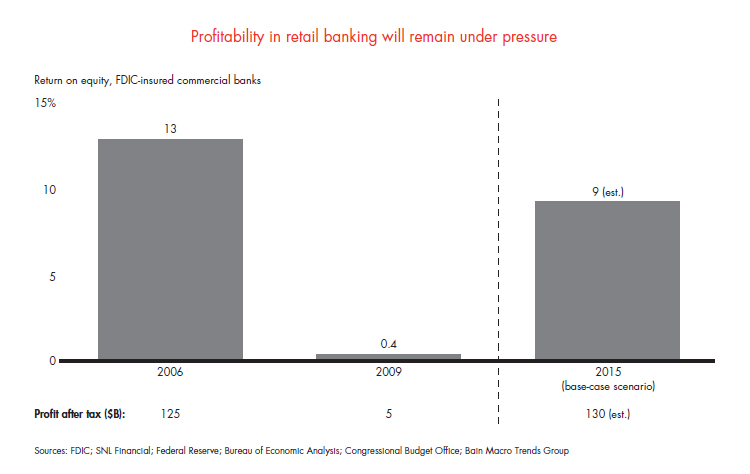
More banks are coming to recognize that the way forward requires capturing the economics of customer loyalty, while dramatically reducing costs. They realize that they face a long, steep climb to accomplish this, but they need to find practical first steps that will generate demonstrable progress.
In this report, the 2011 edition of Bain’s annual survey of loyalty in retail banking, we examine where banks have made progress in strengthening customer advocacy and where opportunity still remains. We also delve deeper into the interactions and channels that matter most, to outline specific areas where banks can focus in order to improve customer loyalty most effectively, with the greatest returns.
Working with Research Now, a market research firm, we polled nearly 97,000 account holders from banks and credit unions across the US, Canada, Mexico and Brazil and followed up with 5,100 bank customers to see beyond the routine transactions and zero in on the interactions that customers say matter most to them— those “moments of truth” and “wows” that are decisive to winning their loyalty.
The results are striking. They reveal that most banks have a major opportunity to sharpen their ability to identify the “moments of truth” when customer loyalty is most on the line and make elevating their performance at these key touchpoints the central mission of every employee—from the C-suite to the customerfacing front lines. They also show that there is large potential for banks to strip out costs by streamlining their delivery of high-volume routine transactions that customers say they expect their banks to perform fast and efficiently, but matter little in earning their loyalty. Finally, they clearly identify a special category of interactions that banks can work on to earn customer “wows”—and potentially help convert passive customers into fans—by applying technology in new ways to transform the delivery of a routine service into a winning experience that customers will want to tell their friends and colleagues about.
The payoff for getting this right is considerable. Loyal customers buy more, stay longer, cost less to serve and tell others to become customers, as well. The cumulative effect is that a typical affluent customer who is a promoter is worth nearly $10,000 more over the customer’s lifetime with US banks than one who is a detractor. The long-term winners will be banks that reinvent the industry’s business model to grow the loyalty economics of their customers, rather than constantly undermine them.
2. The loyalty leaders
Customer loyalty is not another initiative that banks can drive; loyalty can only be earned over time. It is a way of doing business built patiently on a foundation of daily leadership, behaviors and actions, with a culture of continuous improvement. A focus on winning customers who are passionate promoters originates at the bank’s senior-most levels, permeates the organization’s culture, and is cultivated and refined over a period of years. (For a description of what it takes to build a customer loyalty system focused on winning promoters, see below, “Net Promoter®: A system for measuring and strengthening customer loyalty.”) Given that it takes time to earn customer loyalty, it is not surprising to find that, as groups, direct banks, community banks and credit unions placed atop the loyalty rankings once again in 2011. Furthermore, they continued to extend their lead over the bigger banks.
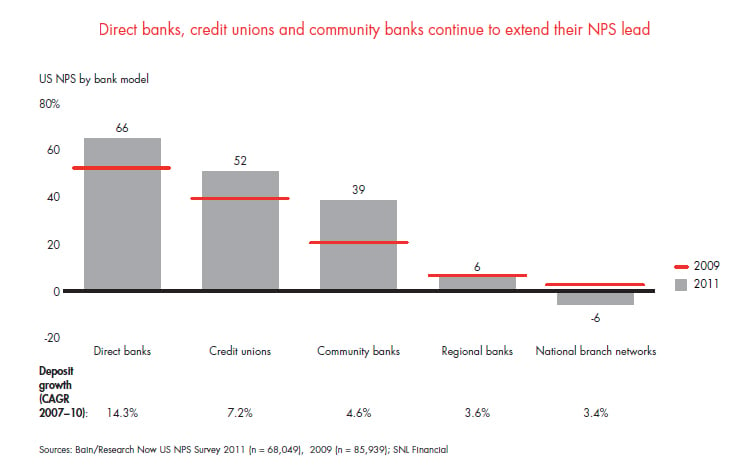
Taken together, the regional banks and the national branch network banks in our survey made little headway with customers over the past two years. With an average NPS that, respectively, remained flat at plus 6 and dropped to minus 6, these institutions pay a steep price for their lower loyalty scores. Their average deposit growth rates compounded over the period from 2007 through 2010 were just 3.6 percent for the regionals and 3.4 percent for the nationals. The annual deposit growth rates for the direct banks and the credit unions, by contrast, were far healthier at 14.3 percent and 7.2 percent, respectively.
The big banks are not doomed to subpar loyalty, however. There are notable success stories, particularly among the regional banks. PNC, M&T Bank and TD Bank in the Northeast; PNC and SunTrust in the South; Huntington National Bank in the Midwest; and Bank of the West on the West Coast all earned strong customer NPS. Ixe Banco in Mexico, TD Canada Trust in Canada and Banco Itaú in Brazil topped the loyalty rankings in their markets. Customers we spoke to were full of praise for the qualities that set these banks apart. “They provide every service I require, and the personnel are always friendly and helpful,” said a PNC customer. “Great customer service; great options!” said a SunTrust customer. “My bank treats me like I’m someone special,” said a Canadian account holder at TD Canada Trust. “Excellent service,” said a customer of Brazil’s Banco Itaú, who went on to praise the bank’s “great availability of channels and adequate lines of credit for my needs, and good and transparent information.”
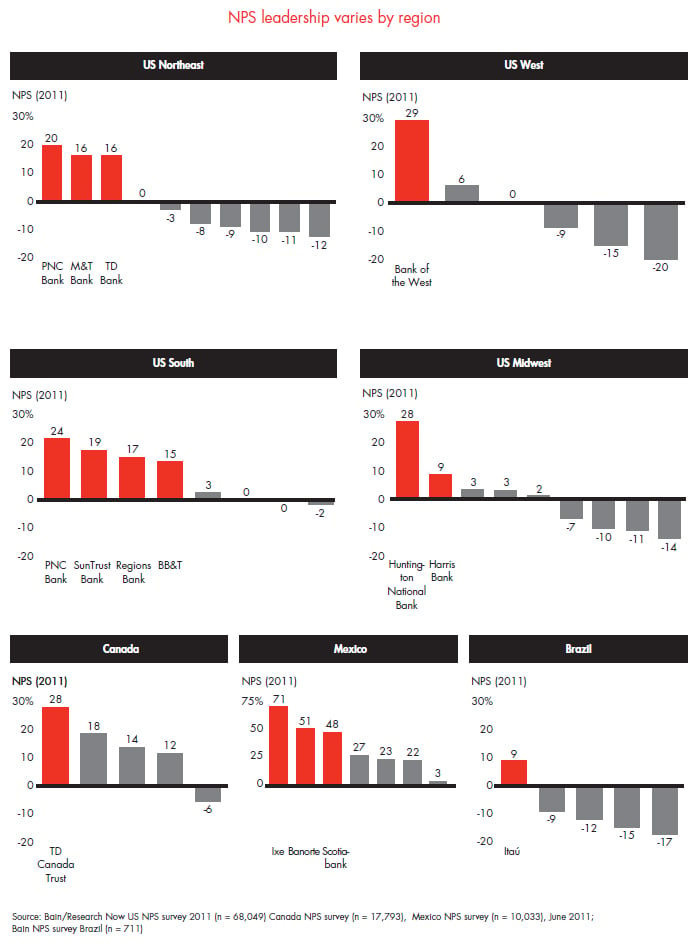
Furthermore, some regionals have been demonstrating strong improvement over time. Of the 18 national and regional banks in the Bain 2011 survey, two out of three recorded improved Net Promoter scores over the past year. M&T Bank showed the biggest gain, with its NPS jumping 14 points since 2009. Regions Bank and SunTrust each saw its score increase by 8 points over the same period. PNC, in the Northeast, and Huntington Bank, in the Midwest, each jumped two places in the rankings since 2009 to take the top positions in their respective regions in 2011.
While the incremental gains are welcome, the larger retail banks have vast opportunities to make breakthrough improvements in customer loyalty, particularly with the customers who should be their most important and profitable targets—mid-career and more affluent account holders. Scores are lowest and progress slowest among customers who are in their prime household-formation and family-commitment ages of 25 to 55. Banks miss a major opportunity when they fail to connect with these attractive maturing customers, whose banking habits and loyalties are established as they explore the market for an expanding range of investment and credit products and advice.
Banks fare even worse with wealthy customers, and their standing with this key group has deteriorated over the past year. Loyalty declines as customers’ investable assets increase, with detractors outnumbering promoters by wider margins. With an NPS of minus 12, wealthy customers who control investable assets exceeding $1 million gave the lowest scores.
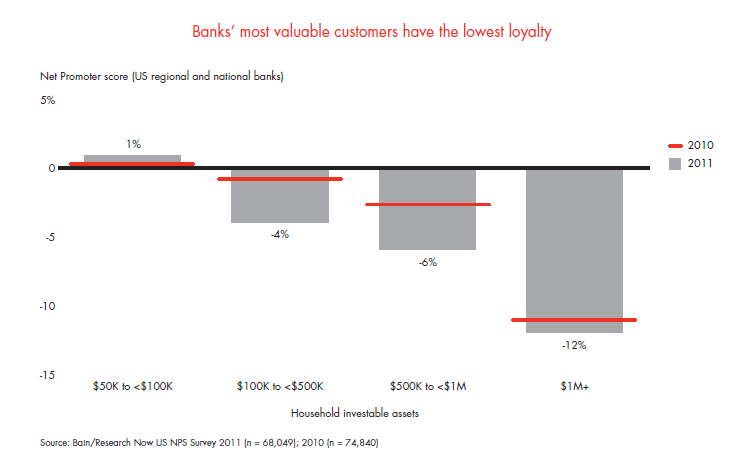
The opportunity—and the need—for improvement is clear, especially among the most valuable customer segments. That some bigger banks can earn their customers’ loyalty has been demonstrated by regional loyalty leaders. For example, Ixe, Mexico’s top-rated bank, assigns dedicated relationship managers to provide personal-banking services to affluent customers, including home delivery of cash withdrawals, currency exchange and other conveniences. For banks that aim to improve their loyalty scores, the issue becomes, how can they earn customer loyalty?
3. Why loyalty leaders are leading
Smaller banks may not boast an extensive branch footprint, offer a wide array of financial products or position an ATM in every mall or street corner. But while these features do matter for customer acquisition, physical infrastructure is not what earns customer loyalty. When we asked customers why they are—or are not— likely to recommend their bank, it became clear that loyalty is built around a set of qualities that define their experiences and relationships. In our survey, we asked customers to describe in their own words what accounted for their willingness to recommend their bank, and then we categorized the number of positive and negative reasons given per 100 respondents. Exceptional customer service topped the list of positives, eliciting more spontaneous favorable mentions than any other attribute. Service also ranked high among the attributes that drew the largest number of negative comments.
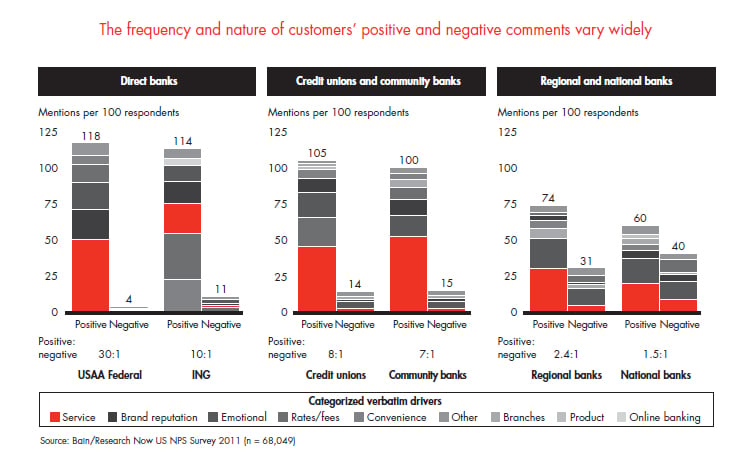
What else matters? Customers told us that brand reputation and convenience were also important. But the specific qualities that drew praise and criticism vary by bank, reflecting each bank’s distinctive strengths and weaknesses. For example, customers of ING Direct cited favorable rates and fees and convenience ahead of service.
Another notable difference between loyalty leaders and laggards is the ratio of positive to negative comments. It is striking how much more unprompted praise customers heaped on the top-scoring banks, in contrast to the relative scarcity of positive things they had to say about banks that earned lower loyalty scores. For example, when we asked direct bank customers to describe why they rated their banks the way they did, the number of positive comments exceeded the number of negative things they had to say by a margin of better than 10 to one. Customers of the average national or regional bank, by contrast, gave just two positive mentions for each negative one.
Some leading regional banks are doing a better job of giving customers more reasons to praise them. For example, most of the regional loyalty leaders mentioned previously earned a healthier ratio of at least three positive comments for each negative one. That correlates closely with the banks’ higher Net Promoter scores. Customers gave Bank of the West an NPS of 29, the highest in the US and Canada among the larger banks. They offered praise for, among other things, the bank’s service and the care it demonstrates for their well-being; positive comments were five times more common than critical statements. By contrast, the number of positive and negative comments for the two lowest-rated national network banks was just about equal. They earned an NPS of minus 20. It is a pattern that held up from region to region across all the markets we examined.
Generating a high volume of unprompted positive customer comments is important for banks, not just for what they reveal about what the bank is doing that is working, but also because it is a powerful source of authentic brand building and referrals. This is critically important in today’s networked world, where Facebook, Twitter and other social media give customers a digital megaphone, amplifying the impact of what they have to say, whether it is positive or negative. Banks that fail to earn and sustain positive customer buzz will miss out on a powerful tool for building their brand. Those that draw negative commentary risk destroying it.
There is an important message to banks in the dramatically different ways customers talk about the ones that earn their loyalty and those that do not. Banks rightly tend to focus first on ways to eliminate defects that give rise to negative customer comments. However, they often struggle to imagine the ways they can earn real enthusiasm from their customers. We often hear bank executives question whether genuine enthusiasm is even possible in financial services—after all, the products are not inherently as engaging as the latest wireless gadget. But the large volume of powerful positive commentary earned by USAA and ING Direct shows that it can be done. Larger branch-based banks can do it as well, with PNC earning 84 positive comments for every 100 customers. Banks can and must find ways to not only eliminate sources of dissatisfaction but also to fire up genuine customer excitement. We will explore how to do this in the remaining sections of this report.
4. Which interactions matter
Three striking findings emerged from the 2011 survey. First, the vast majority of high-frequency routine transactions do not matter much to loyalty, but are very costly to banks. Second, the relatively infrequent “moment of truth” interactions have a dramatic impact on loyalty, but are often overlooked. Third, there are game-changing opportunities to improve the loyalty of large numbers of customers by designing and delivering digital experiences that earn customer “wows” by making routine interactions quicker, easier and more enjoyable.
Most customers’ bank interactions are so mundane that they barely attract the account holder’s notice, unless a rare breakdown—a check that doesn’t clear on time, for example, or a misrouted payment to a creditor—briefly thrusts it to the forefront. Our analysis found that only a half-dozen or so routine transactions— including cash withdrawals, simple deposits, balance inquiries and fund transfers—constitute the overwhelming majority of customers’ interactions with their banks. Customers told us that they make more than 50 balance inquires a year, for example, accounting for 31 percent of their total bank interactions. To a surprisingly high degree, customers still tend to conduct them at high-cost branch offices—30 percent of survey respondents reported that they visit a branch for their routine banking.
Banks understand that they need to practice good hygiene by executing routine transactions with Six Sigma reliability, and most have mastered these fundamentals. There is little to be gained by investing in incremental improvements, yet many loyalty leaders may be over-delivering with thousands of employees and acres of real estate dedicated to routine transactions, driving up their costs far beyond the payoff. Our analysis shows that superior performance or the “human touch” at routine interactions, like taking deposits or handling withdrawals, is not a meaningful factor accounting for the loyalty gap between the leaders from the laggards. Customers value speed and efficiency, and they expect flawless performance. They do not reward their bank for delivering more than that.
As unimportant as routine interactions are for earning customer loyalty, they continue to pump up costs in branches and call centers. Despite years of efforts by banks to remove them from their branches, fully threequarters of branch interactions are for routine transactions—the vast majority of which could be handled by lower-cost self-service channels. But banks not only drive up costs when they allow customers to clog up branches with ordinary deposits at teller stations, they also distract branch employees from the much more important interactions that should be the focus of live channels.
It is the more complex, infrequent interactions—applying for a mortgage, replacing a lost or stolen credit card, or resolving fraudulent account activity, for example—that set the leaders apart. These high-stakes “moments of truth” may comprise less than 10 percent of all customer transactions, but it’s where the battle for loyalty is won or lost. They are the touchpoints with the greatest potential to create detractors when they go wrong and win loyal promoters when they are handled well.
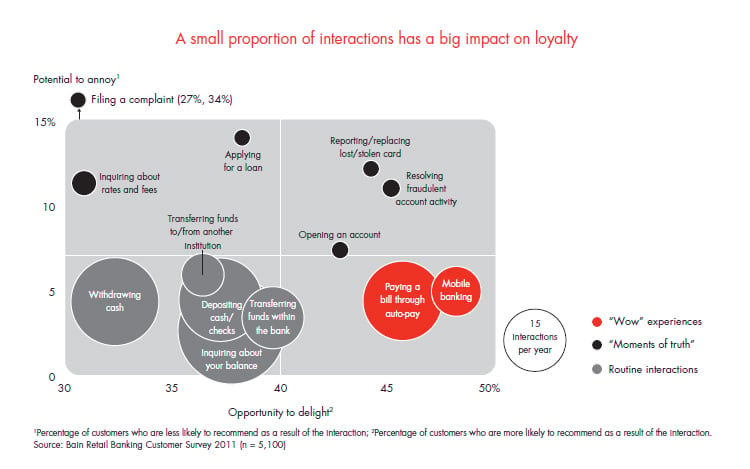
Many banks handicap their ability to win over customers at “moments of truth” because the frontline employees— whether in a branch or a call center— they count on to deliver exceptional service are focused on processing routine transactions. Instead, banks need to liberate employees from the high-volume drudgery and rethink what they need from a loyalty-winning workforce. With a focus on building trust and a service-oriented culture, banks that connect with customers hire talent with strong interpersonal skills. They then train them and back them up with policies and procedures that prepare them to come through for customers when it matters most.
Customers are clear about what they are looking for from their banks at “moments of truth.” The transaction should be easy to navigate and speedy to complete, of course, but customers especially value receiving personal help and advice from a knowledgeable bank employee. Indeed, in our survey, what most distinguishes loyalty leaders from the rest is their performance at “moments of truth,” when customers have a far greater need for personal service, whether delivered face-to-face in branch offices or over the phone. For banks that rank among the leaders, 31 percent of customers told us that their experience at a “moment of truth” increased their likelihood to recommend their bank, versus only 21 percent of customers at other banks.
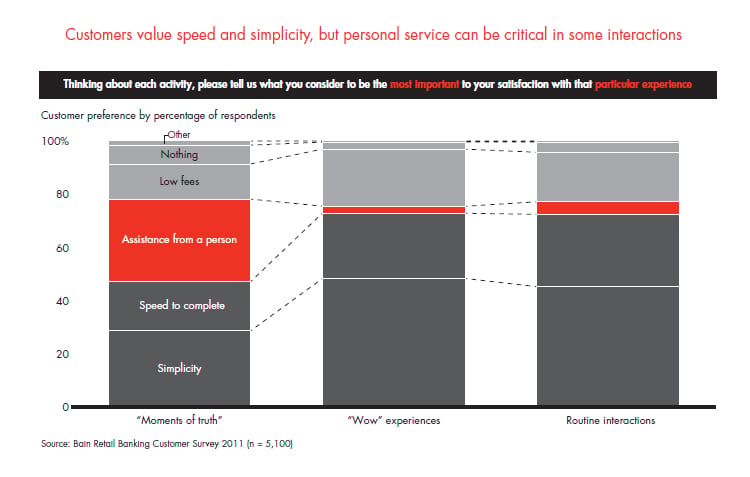
Perhaps the most intriguing opportunities lie in the “wow” transactions that both surprise and delight customers. These interactions apply technology to transform common high-volume transactions, like depositing a check or transferring funds between accounts, into experiences that are so much more convenient, faster and just plain “cool” that customers will want to tell others about them. Breakthrough innovations are winning customer “wows” and earning positive buzz by taking advantage of new digital platforms like smart phone technology and wireless tablet devices to offer automated bill pay and enable mobile deposits by capturing a check’s digital image remotely.
Creating “wow” experiences is powerful for four reasons. First, they give customers compelling reasons to move routine transactions out of branches and call centers, simultaneously increasing speed and convenience for the account holder while driving down costs for the bank.
Second, they have high volume and reliability in winning loyalty. “Wow” interactions happen more frequently than do the relatively rare “moments of truth,” giving banks that can earn “wows” more opportunities to win promoters and convert otherwise passive customers into fans. In addition, customers reported that “wow” moments had a higher probability of increasing their willingness to recommend their banks than any other interaction.
Third, innovations that become “wows” can be surprisingly enduring. For example, online bill paying continues to win over customers and remains a powerful loyalty driver among banks more than a decade after its first use to replace writing and mailing paper checks as a mainstream way to settle accounts.
Finally, by investing in “wows,” bigger regional and national banks can more quickly close the loyalty gap with their smaller competitors. With their deeper pockets and advantages of scale, they are better positioned than local banks to earn promoters through digital innovation.
Banks are just beginning to capture the vast potential of “wow” interactions. Our research shows that fewer than 10 percent of the customers over age 35 have begun to use mobile banking. But the early adopters are embracing the new technology for a wide range of interactions that only hint at its promise. More than 80 percent of their mobile use is for balance inquiries, transferring funds and making deposits, among other routine transactions that untether them from branches, tellers and even ATMs. Early customer feedback suggests that this new banking option is yielding dividends both in terms of likely cost savings for banks and new opportunities to earn more promoters.
5. What to do
The evidence from the latest retail banking customer loyalty survey suggests a clear agenda for banks to reignite profitable growth. Three key priorities belong at the top of any retail bank’s “to do” list, whether it is a loyalty leader or laggard, or it has a footprint that is regional or national. First, banks need to “industrialize” the delivery of routine transactions through step-function reductions in costs while improving convenience, speed and efficiency. Second, they must hone disciplines that will enable them to steadily boost the delivery of exceptional experiences at those “moments of truth” that matter most to consumers. Third, they need to step up efforts to develop breakthrough digital innovations that create experiences that earn customer “wows.”
“Industrialize” routine transactions to drive out costs. Banks have waged perennial campaigns to reduce costs, but surprisingly large opportunities remain to drive them down further—even as they improve customer loyalty. Overall, three-quarters of the interactions customers have with their banks through branch offices consist of such routine transactions as making deposits, withdrawals, inquiring about their balance and transferring funds.
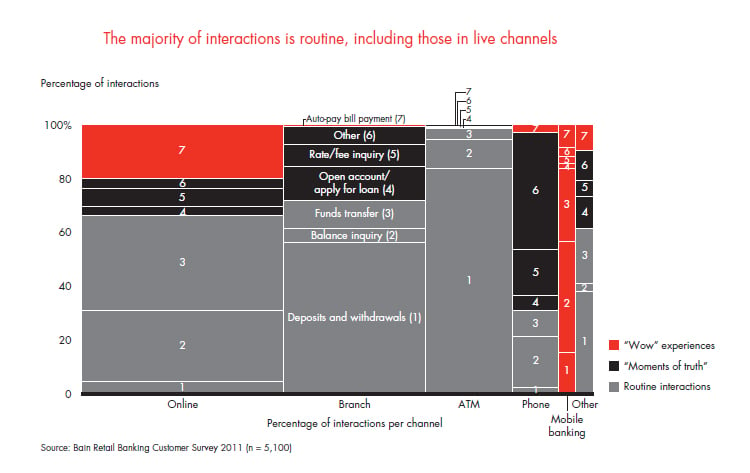
Though better than their smaller peers at using technology for basic customer interactions, even the big regional and national branch banks remain too reliant on high-cost channels for taking deposits, handling withdrawals and fielding common balance inquiries. Bain research has found that the customers of some of America’s biggest banks rely on branches and call centers to handle between 25 percent and 40 percent of their routine transactions.
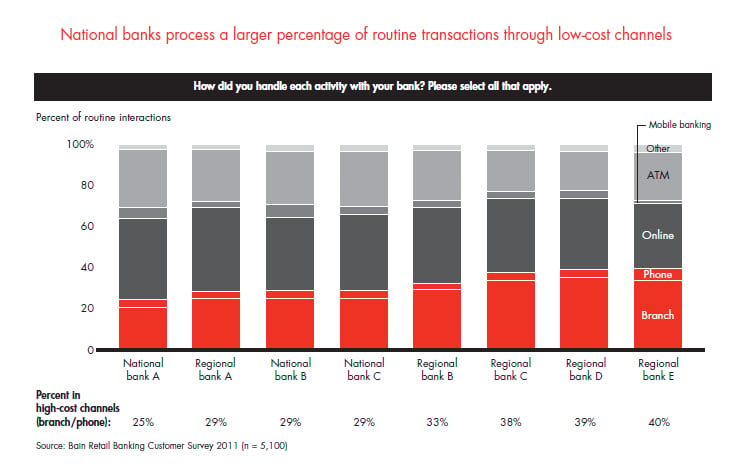
This presents a challenge but also an opportunity to take a customer-led approach to cost reduction. Banks are beginning to tackle this challenge with approaches that can dramatically lower costs, while better meeting customers’ expectations.
Make it easier. Banks are luring customers to low-cost channels for everyday transactions, using enhanced ATM technology to simplify deposits, transfers and withdrawals. For example, Bank of America and Wells Fargo, among others, now make it possible for customers to deposit checks and currency in ATMs without first having to fill out a slip or use an envelope. Attractive, more intuitive ATM screens and interfaces enhance ease of use. Stand-alone automated bank kiosks in shopping malls, convenience stores and at transportation hubs render branch visits less necessary.
Transition to teller-free branches. Customers cannot conduct routine transactions at teller windows when there are no teller windows in the first place. Banks have been too hesitant to strip them out of their branches for fear that taking that bold step would alienate account holders. Done thoughtfully and over time, however, a program to go “teller free” can help achieve three important goals: providing better service when it matters most, enriching the jobs frontline employees in branches do by retaining and retraining them, and significantly reducing operating costs.
Bain’s experience working with banks that have done this has shown that taking a “hub and spoke” approach is one effective way to make a successful transition. The program begins by identifying branches in locations that serve the bank’s most valuable customers—perhaps small-business owners who, in addition to routine interactions, often need help with more complex issues. With full-service banking limited to hub offices, the bank can then replace teller windows with ATMs in surrounding branches for routine transactions and focus instead on relationship management, selling and service. As they gain confidence in the new approach, banks continue to capture cost savings and increase customer convenience by reconfiguring and shrinking the spoke branches and enhancing services offered at the hubs. Some European banks, including Caisse d’Epargne and BNP Paribas, are already well along this path to lean retail banking, having gone teller-less in as many as 80 percent of their branches. Converting former fullservice branches into attractive sales “showrooms,” they staff the new offices with representatives who are trained—and incentivized—to guide customers through more complex transactions, offer customized advice appropriate to their financial needs and cross-sell bank products that help meet them.
Double down on “moments of truth.” Resources freed up by shifting routine transactions to lower-cost channels can be plowed into the highest-value touchpoints that customers consistently tell us matter most.
Begin by eliminating defects at those high-impact touchpoints that have the greatest propensity to create detractors before turning to the work of creating experiences that delight. Making progress on delivering great customer experiences at “moments of truth” requires a sustained and disciplined effort to listen to the voice of the customer and, using a closed-loop feedback system, to channel what is learned into actions that mobilize the entire organization.
Banks that do this well monitor day in and day out service delivery at key touchpoints with short, frequent surveys that invite customers to provide immediate feedback following a ”moment of truth” interaction. Typically consisting of just two questions, the survey asks customers to rate how likely they are to recommend their banks to friends or colleagues based on their most recent experience. It also encourages respondents to briefly explain why they gave the rating they did. This feedback is used not only for tracking results, but also to allow supervisors to follow up with unhappy customers within 24 hours in order to restore—or even strengthen— relationships, provide feedback and coaching to their frontline reports and identify systematic problems that need to be resolved.
The job of converting high-level insights into loyalty-winning actions in the trenches involves employees from all stations in the bank. Cross-functional teams map customer experiences end-to-end to trace moments of truth and to improve them, tackling everything from product design, policies, systems and processes to frontline training and procedures.
One of the greatest benefits of listening to the voice of the customer shows up only when the bottom-up survey results flow back to the frontline employees who delivered the service. Listening to the follow-up calls, the frontline employees hear directly from customers themselves what worked and, coached by their supervisors, learn how they can improve their future performance. With other members of their work teams, they discuss how they can apply the insights gathered from the calls to elevate their team scores. They also pass along to middle management how changes in policies and processes that the support staff does not directly control can remove barriers that will make it possible to deliver experiences that win more promoters.
Telephone call centers are a good example of this phenomenon. Established in the pre-Internet days to give customers a quick way to resolve basic issues, they have become a favorite target for cost cutting. Loyalty leaders are taking a new course, reaping huge rewards by converting call centers into centers of service excellence. One North American bank, for example, discovered that its most productive loan collection agents use empathy to coax payments from delinquent customers who are grateful to have a sympathetic listener on the other end of the line. Once the bank began recruiting, training and compensating loan collection staff to encourage this sort of behavior, collection rates and both customer and employee loyalty significantly improved.
Invest in winning “wows.” For banks that can design and deliver them, “wow” experiences yield a double benefit. They generate savings because they continue to drive frequent interactions through low-cost channels. They also serve as loyalty game changers when “wow” experiences exceed customers’ expectations by making banking easy.
The novelty of “wow” experiences makes them especially potent. Banks that are first to market with “wows” stand to get a head start generating positive word of mouth—and referrals—from customers who are eager to tell their friends about their cool new tool.
What kinds of interactions win “wows”? Typically, they involve applications of new technology to a familiar transaction, increasing speed, convenience and functionality. Mobile wireless technology and stronger data encryption have opened a multitude of new possibilities that banks are just beginning to bring to market. But the proliferation of opportunities and the major investments required to ensure that the new technology will be embraced by customers make it essential for banks to place their bets carefully.
For example, JPMorgan Chase’s QuickDeposit™ mobile app enables customers to deposit checks remotely, using the improved image-capture capabilities of smart phones. Customers can transmit photographs of their checks, which are then credited directly into their checking or savings accounts. Citibank also recently unveiled an application that takes advantage of larger digital tablet displays, converting an Apple iPad into a personal branch, conveniently on a screen. Citibank’s free app lets its customers manage their bank and credit card accounts, check balances, set up transfers and make payments—all with a swipe.
The benefits multiply when this is all put together. Providing new, easy ways for customers to do routine transactions through self-service channels can generate “wows” that earn lasting loyalty, while also siphoning off volume from high-cost live channels. Branches and call centers newly focused on delighting customers at “moments of truth” will also earn greater customer loyalty more consistently. A parallel push to speed the migration of routine transactions from the branches can free up headcount and investment resources, better used for “moments of truth” and “wows.” While we have underscored that it takes years to become a loyalty leader, taking a pragmatic, focused approach to the right areas can result in measurable, demonstrable progress in a year and be self-funding to boot.
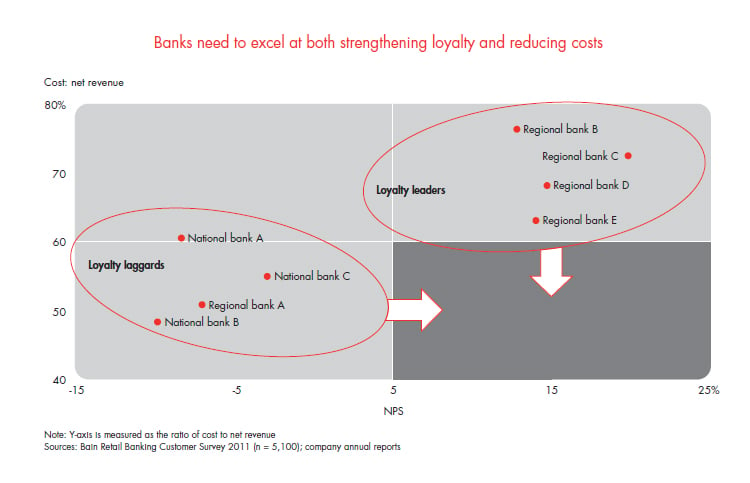
The environment retail banks will be facing over the coming years could not be more challenging. But it will also be a time of vast opportunities and fluid change. More than ever, competition will be waged on a battlefi eld to win customers’ hearts, minds and wallets. Different banks will bring diverse strengths and weaknesses to this campaign. With their relative lead in earning customer loyalty, regional banks will need to gain better control over their cost structures. Big banks will want to continue wielding their advantages of scale as they learn to become as nimble and customer-friendly as the direct banks and community banks are today. Every bank will need to do a better job of innovating as it competes to earn its customers’ loyalty and the economic rewards that produces.
Appendix: Methodology
Bain & Company partnered with Research Now, the online global market research organization, to survey consumer panels in the United States, Canada and Mexico. The survey’s purpose was to gauge customers’ loyalty to their principal bank and the underlying reasons they hold the views they do. Conducted in June and July 2011, the survey polled 95,875 customers of national branch network banks, regional banks, private banks, direct banks, community banks and credit unions in the US, Canada and Mexico. We included in the individual bank analysis only those banks for which we received at least 180 valid responses. We grouped all community banks and credit unions together and evaluated the responses we received from their customers as a single business-model category. Bain also surveyed 711 retail bank customers in Brazil. Given the smaller overall sample size, individual Net Promoter scores are based on the responses of between 65 and 130 participants.
The respondent sample: To reflect the banking market and ensure robust, statistically valid results, the respondent sample included somewhat higher proportions of middle-aged people and affluent households than the overall US population. By age, people between 36 and 55 make up 28 percent of the total population, but account for 41 percent of all respondents. By contrast, households headed by people who range in age from 18 to 25 are 13 percent of the population as a whole but 7 percent of the survey sample. Likewise, by income, households earning less than $49,000 annually comprise 55 percent of the total population but only 32 percent of our sample. Those earning more than $100,000 a year are 14 percent of the population but 27 percent of our sample. Each of the four regions of the US represented in our sample is approximately the same proportion as its actual population.
Survey questions: The survey questionnaire consisted of 10 main questions. Once respondents identified their primary bank, they were asked the following three questions to assess their loyalty to that institution:
- On a scale of zero to 10, where zero represents “not at all likely” and 10 represents “extremely likely,” how likely are you to recommend your primary bank to a friend or relative?
- Tell us why you gave your primary bank the score you did.
- In the last year, how many times did you recommend your primary bank to a friend or relative?
Respondents were then asked to identify the major products they held with their bank and the channels they use to do their banking. The remaining questions elicited demographic profile information: household income, investable assets and region of residence.
Analysis of respondent comments: For each of the four bank categories, we randomly sampled more than 13,000 open-ended verbatim comments that respondents offered as the chief reasons they gave their banks the scores they did. We coded the comments into 66 categories. We then grouped related categories into the 10 meta-categories as listed below:
- ATMs: General ATM; location/quantity; ease of use; features/services offered; safety/security; international availability
- Convenience: Proactive communication; account security/ID theft; secure systems; timely statements/bills; clear and accurate communications; serious error resolution
- Branches: General branch; quantity of locations; hours of operation; cleanliness/atmosphere; wait time in line
- Brand reputation: General reputation; trustworthiness; size/stability; reliability
- Emotional: General emotional; sense of loyalty; there when needed; better than other providers
- Fees: General fees; ATM; CD; current/checking account; money market account; savings account; overdraft; wire transfer; international; online; added/changed/ hidden/transparent; credit cards
- Online banking: General online; bill pay; easy/user friendly; features/services offered
- Product: General product; CD; checking; investing; mobile banking; mortgage; savings; loan/line of credit; rewards; credit cards
- Rates: General rates; mortgage; CD; deposit; line of credit; loan
- Service: General service; friendliness; helpfulness; knowledgeable; feel valued; understand my needs; problem resolution; speed
State to region mapping: Banks in the 50 US states and District of Columbia were assigned to the following four regions:
- Midwest: IA, IL, IN, KS, MI, MN, MO, ND, NE, OH, SD, WI
- Northeast: CT, MA, ME, NH, NJ, NY, PA, RI, VT
- South: AL, AR, DC, DE, FL, GA, KY, LA, MD, MS, NC, OK, SC, TN, TX, VA, WV
- West: AK, AZ, CA, CO, HI, ID, MT, NM, NV, OR, UT, WA, WY
Statistical significance of findings: The results of our data analysis are robust both for the measurement of bank NPS by region and for respondent NPS for each demographic category. The NPS measured for each bank included in the regional rankings is statistically significant to an 80 percent confidence level, with a two-tailed test of the confidence interval ranging from plus or minus 1.6 percent (n ≥ 4,000) to plus or minus 7.5 percent (n = 180).
For the analysis of NPS by demographic subcategories of respondents’ ages, incomes, genders and investable assets, we again aimed for results that would be statistically significant at the 80 percent confidence level. Given the large size of our overall sample (n = 68,049 in the US) and its overweighting in some age, income and affluence categories, the confidence interval for most demographic subgroups is plus or minus 0.4 percent. For the numerically smallest subcategory of respondents (those having investable assets greater than $1 million), the number in our survey sample was 2,900, yielding a confidence interval of plus or minus 2.0 percent so that the NPS score they provided would be significant at the 80 percent level.
Net Promoter®: A system for measuring and strengthening customer loyalty
An effective loyalty system comprises eight essential elements:
- A reliable metric provides a dependable method for sorting customers into promoters, passives and detractors, and for gaining an understanding of its competitive position. The Net Promoter score (NPS®) helps fulfill both requirements. By asking customers to rate on a scale from zero to 10 how likely they would be to recommend their bank to a friend or relative, and why they gave the rating they did, companies can identify their promoters (those responding with scores of nine or 10), passives (who answer with a seven or eight) and detractors (giving scores from zero to six). To calculate a company’s NPS, simply subtract the percentage of customers who are detractors from the percentage who are promoters.
- Loyalty economics are calculations and analysis that provide a true understanding of the costs and benefits of investing in different segments of your customer base to earn more of their loyalty.
- Root cause analysis is the process for mining customer feedback and other sources of data to gain deeper insights into what the organization can do to create more promoters and fewer detractors.
- Closed-loop feedback, one of the most important elements of an effective Net Promoter system, is direct input from customers that is shared with employees. They, in turn, respond to the customers who provided feedback to address their concerns or better understand their sources of delight.
- Learning occurs when employees use customer feedback to understand the impact of their actions on customers. It is also furthered by deliberate processes that help employees experiment and get the coaching they need to improve their performance.
- Action is the bias of Net Promoter companies that move beyond collecting feedback and monitoring their scores to take steps to change day-to-day behaviors that further the pursuit of customer advocacy.
- Operational infrastructure in the form of robust processes, policies and information flows supports a high-quality closed-loop system and the actions that move the organization beyond customer research to constitute its everyday work on customers’ behalf.
- Leadership and communication are critical roles for senior management who demonstrate their own commitment to earning customer and employee loyalty by instilling values in the organization and reinforcing them through their actions, decisions and words.
For a complete description of the Net Promoter system and how scores of companies, including banks, are using NPS to help realize culture change, improvements and greater business impact, see The Ultimate Question 2.0 (Harvard Business Review Press, 2011) by Bain partners Fred Reichheld and Rob Markey. Updates, forums and additional information can also be found on the Net Promoter website.









